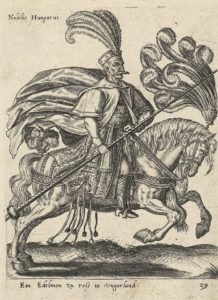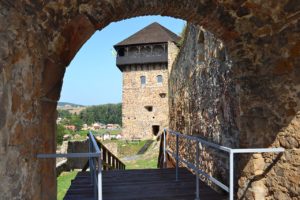
November 21, 1593, The Hungarians defeated the Turks at Romhány

This event took place at the beginning of the 15-Year-War, in the northern part of the Kingdom of Hungary. An army of Hungarian nobles from the Highlands aka Upper Lands of Hungary scattered the united troops of the Ottoman Sandjaks at Romhány. The so-called “noble resurrection” was a traditional way for the kingdom’s noblemen to join the war when they were summoned by the ruler. Their military power differed from the value of seasoned mercenaries. Many of these noblemen regarded themselves as members of the Valiant order, though. You can read about the Valiant Order here:
https://www.hungarianottomanwars.com/essays/members-of-the-valiant-order/
However, the experience that they had acquired during the many generations fighting on the Borderland was not negligible. They were organized in units called “banderium”. The banderium was a military unit that was distinguished by the banner of a high-ranking clergyman or nobleman in the medieval Kingdom of Hungary. Its name is derived from the Latin or Italian words for the banner (banerium and bandiera, respectively). In 1526, the maximum number of such noblemen was altogether 60,000 people who assembled, including the armed peasants in different locations of the kingdom.

The start of the campaign in Nógrád also prompted the local Ottoman forces to take action. As the Pasha of Buda was wounded in the battle of Pákozd (November 3), he was unable to take part in the operation in person. Instead, the Ottoman beys of Szolnok, Szécsény, Nógrád, and the beys of Gyula took part in the action with the troops of Temesvár (Timisoara) Vilayet. They planned to attack the Christian camp at Fülek (Filakovo) castle, annihilate the Hungarian army, and lift the siege around the castle. Here is more about the happenings of this year:

However, Captain Teuffenbach of Kassa (Kaschau, Košice) learned of the plan from either a spy or a peasant and launched an attack against the Ottomans at once. However, he could not leave Fülek castle, as his army would have been caught between two fires. to prevent this, he sent out an army of Hungarian noblemen who were mainly cavalrymen. (Please, note, that I use the Oriental name order for Hungarians where family names come first.) Their leader was Báthory István but also high-ranking nobles took part like Homonnai-Drugeth István, Rákóczi Zsigmond (later Prince of Transylvania), and Thököly Sebestyén (grandfather of the later prince).

The chronicle of Decsi Baranyai János writes about this: “Upon hearing this (that is, the news of the approach of the Turks), it was ordered that Báthori István, Homonnai István, Rákóczi Zsigmond should set out without delay to chase the Turks out. They were aided by the captains of Korpona (Krupina) and Zólyom (Zvolen) castles, altogether about four thousand selected cavalries and a few infantrymen. Thus, with the first assault, they beat the Turks, chased them, pursued them, killed them, captured some alive, chased the others to Szécsény castle, occupied their camp and all their military equipment; they returned merrily with 14 Ottoman flags, and lots of booties to their camp.” You can read more about Korpona (Krupina) castle and its warriors in my book:
The Hungarian detachment surprised the enemy at dawn on November 21, when the Turkish camp had just awakened. The army of the Beys had no chance of resisting, the chaos was complete. The Turkish army of 10-12,000 soldiers was crushed by the Hungarian army of about half their size. Verily, the enemy was chased up to Szécsény castle. As it is usual in war, the Ottoman army suffered the greatest losses while fleeing. Several chief Ottoman commanders were also killed, and the total losses numbered a few thousand soldiers.

The Ottoman flags and all the equipment, including cannons, fell into the hands of the Hungarian banderium. The location of the battle is an interesting question. According to most descriptions, the Ottoman camp was located halfway between Fülek and Szécsény so it could not have been the town of Romhány, which belongs to today’s Hungary. However, there is still a deserted place (a “puszta”) called Kis-Romhány (Romhánypuszta; Lipovany, Slovakia) to the southwest of Fülek (Filakovo), presumably the Ottomans camped here.
In his study of the battle, the Hungarian historian Tóth Sándor László mentions the event as the Battle of Fülek-Romhány, referring to the fact that the military goal for both parties was the taking of Fülek castle. On the one hand, the Ottomans wanted to relieve the siege, and on the other hand, for the Christians, continuing the siege was a matter of life and death.

The fear of having to quit the siege was the reason why Teuffenbach didn’t want to march with his entire army against the Ottoman reinforcing army so as not to fall between two enemies. He continued the siege with a considerable part of the infantry during the battle. The victory at Romhány created the opportunity to continue the siege of Fülek and then bring it to a successful end.
Source: Szibler Gábor

Dear Readers, I can only make this content available through small donations or by selling my books or T-shirts.
If you like my writings, please feel free to support me with a coffee here:
You can check out my books on Amazon or Draft2Digital, they are available in hardcover, paperback, or ebook:
https://www.amazon.com/dp/198020490X
or at https://books2read.com/b/boYd81


My work can also be followed and supported on Patreon: Become a Patron!http://Become a Patron!


https://hungarianottomanwars.myspreadshop.com/

https://hungarianottomanwars.myspreadshop.com/all



